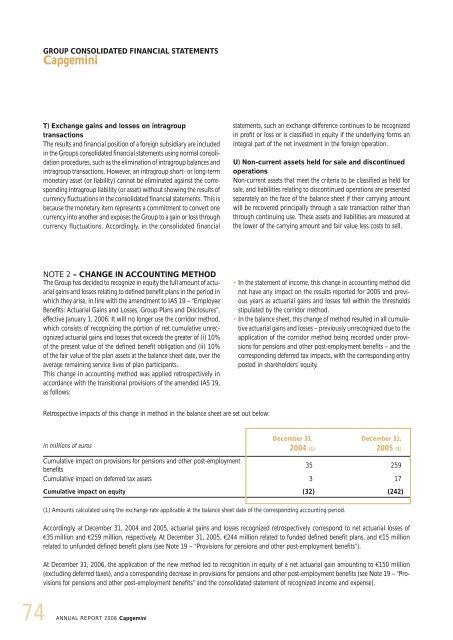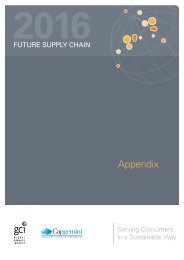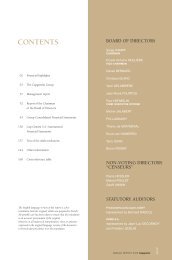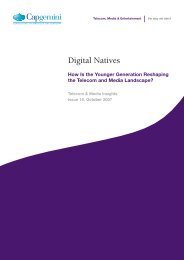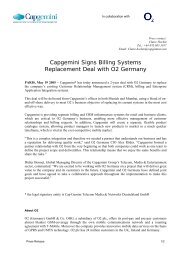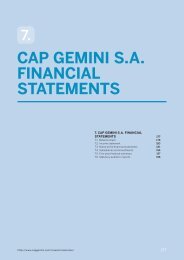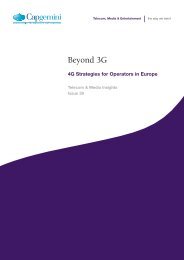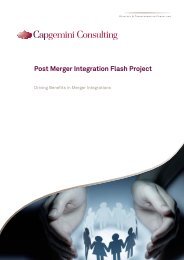Create successful ePaper yourself
Turn your PDF publications into a flip-book with our unique Google optimized e-Paper software.
74 ANNUAL<br />
GROUP CONSOLIDATED FINANCIAL STATEMENTS<br />
<strong>Capgemini</strong><br />
T) Exchange gains and losses on intragroup<br />
transactions<br />
The results and financial position of a foreign subsidiary are included<br />
in the Group’s consolidated financial statements using normal consolidation<br />
procedures, such as the elimination of intragroup balances and<br />
intragroup transactions. However, an intragroup short- or long-term<br />
monetary asset (or liability) cannot be eliminated against the corresponding<br />
intragroup liability (or asset) without showing the results of<br />
currency fluctuations in the consolidated financial statements. This is<br />
because the monetary item represents a commitment to convert one<br />
currency into another and exposes the Group to a gain or loss through<br />
currency fluctuations. Accordingly, in the consolidated financial<br />
NOTE 2 – CHANGE IN ACCOUNTING METHOD<br />
The Group has decided to recognize in equity the full amount of actuarial<br />
gains and losses relating to defined benefit plans in the period in<br />
which they arise, in line with the amendment to IAS 19 – “Employee<br />
Benefits: Actuarial Gains and Losses, Group Plans and Disclosures”,<br />
effective January 1, 2006. It will no longer use the corridor method,<br />
which consists of recognizing the portion of net cumulative unrecognized<br />
actuarial gains and losses that exceeds the greater of (i) 10%<br />
of the present value of the defined benefit obligation and (ii) 10%<br />
of the fair value of the plan assets at the balance sheet date, over the<br />
average remaining service lives of plan participants.<br />
This change in accounting method was applied retrospectively in<br />
accordance with the transitional provisions of the amended IAS 19,<br />
as follows:<br />
Retrospective impacts of this change in method in the balance sheet are set out below:<br />
in millions of euros<br />
REPORT 2006 <strong>Capgemini</strong><br />
statements, such an exchange difference continues to be recognized<br />
in profit or loss or is classified in equity if the underlying forms an<br />
integral part of the net investment in the foreign operation.<br />
U) Non-current assets held for sale and discontinued<br />
operations<br />
Non-current assets that meet the criteria to be classified as held for<br />
sale, and liabilities relating to discontinued operations are presented<br />
separately on the face of the balance sheet if their carrying amount<br />
will be recovered principally through a sale transaction rather than<br />
through continuing use. These assets and liabilities are measured at<br />
the lower of the carrying amount and fair value less costs to sell.<br />
In the statement of income, this change in accounting method did<br />
not have any impact on the results reported for 2005 and previous<br />
years as actuarial gains and losses fell within the thresholds<br />
stipulated by the corridor method.<br />
In the balance sheet, this change of method resulted in all cumulative<br />
actuarial gains and losses – previously unrecognized due to the<br />
application of the corridor method being recorded under provisions<br />
for pensions and other post-employment benefits – and the<br />
corresponding deferred tax impacts, with the corresponding entry<br />
posted in shareholders’ equity.<br />
December 31,<br />
2004 (1)<br />
December 31,<br />
2005 (1)<br />
Cumulative impact on provisions for pensions and other post-employment<br />
benefits<br />
35 259<br />
Cumulative impact on deferred tax assets 3 17<br />
Cumulative impact on equity (32) (242)<br />
(1) Amounts calculated using the exchange rate applicable at the balance sheet date of the corresponding accounting period.<br />
Accordingly, at December 31, 2004 and 2005, actuarial gains and losses recognized retrospectively correspond to net actuarial losses of<br />
€35 million and €259 million, respectively. At December 31, 2005, €244 million related to funded defined benefit plans, and €15 million<br />
related to unfunded defined benefit plans (see Note 19 – “Provisions for pensions and other post-employment benefits”).<br />
At December 31, 2006, the application of the new method led to recognition in equity of a net actuarial gain amounting to €150 million<br />
(excluding deferred taxes), and a corresponding decrease in provisions for pensions and other post-employment benefits (see Note 19 – “Provisions<br />
for pensions and other post-employment benefits” and the consolidated statement of recognized income and expense).


